


The annual Airshow season gives the UK enthusiast a unique opportunity to see aviation history actually operating before our very eyes. Although many countries around the world now have vibrant historic aviation movements in place, the UK still has the most mature and varied array of historic aviation available to the enthusiast, although it has to be understood that this situation could potentially change at any time. We have to be thankful that a number of determined and wealthy fellow enthusiasts are equally besotted with these magnificent machines and they allow us to share in their passion and get close to these extremely valuable pieces of flying history.
Illustrating this point perfectly, the recent VE Day Anniversary Airshow at Duxford airfield was an absolute embarrassment of aviation riches, with so many rare and historically important aircraft on show, that you really were left feeling somewhat spoilt for choice. There is no doubting that I could easily fill a full year of Aerodrome blogs with the delights that were on display at Duxford that weekend, but for this latest edition, we are going to focus on a classic inter-war biplane fighter, which is the only flying example of the type in the world – the delightful Hawker Fury Mk.I.
As far as aviation development was concerned, the 1930s were perhaps the most interesting period in the history of powered flight. During this time, some of the most capable and best-looking aircraft designs were to be produced, as aeronautical engineering and engine technology pushed new boundaries and the style and exuberance of the time found its way into aviation thinking. It could be argued that engine technology actually outstripped that of aviation design as more and more power was generated from the latest engines, which were then to be attached to bi-plane aeroplanes, which had just about reached the zenith of their potential. As aircraft designers realised this fact, the first of the mighty monoplane fighters began to enter development and take advantage of the new, powerful engine designs and push aviation to new levels of speed, height and endurance. During this ten-year period, the world saw aeroplanes progress from the 142 mph Handley Page Heyford twin-engine bomber, to the 367 mph Supermarine Spitfire – the day of the monoplane was definitely just around the corner.
Before the aviation world finally turned its back on biplane aircraft, the 1930s saw the production of the ultimate biplane designs, many of which remain as some of the best loved aeroplanes to ever take to the skies. These beautiful aircraft just seem to epitomise the glamour and excitement of aviation, which simply captivated the general population, who could not get enough of these awesome machines. With highly polished metal panels and brightly coloured flamboyant liveries, it is no wonder that these inter-war aircraft command such affection amongst aviation enthusiasts to this day, even though few aircraft actually remain in flying condition.
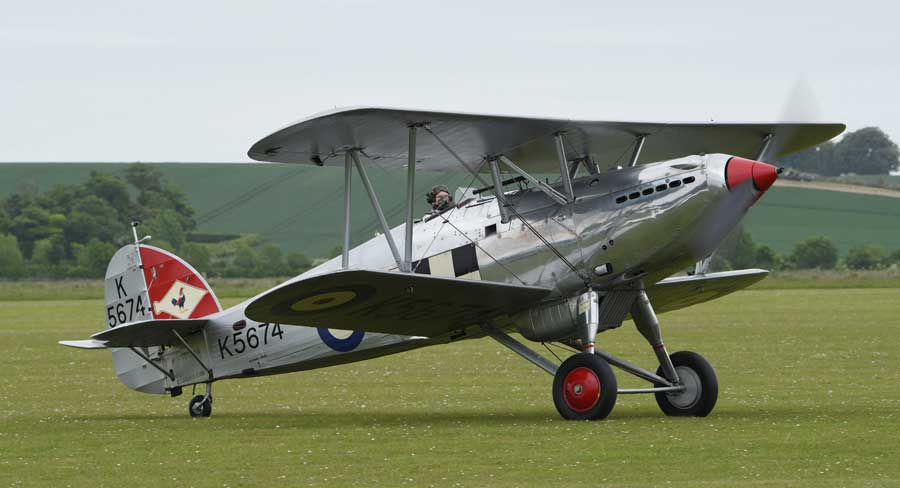
One of the most accomplished aircraft engineers Britain has ever produced was Sir Sidney Camm, the chief designer of the Hawker Aircraft Company. A prolific and talented designer, Camm was responsible for no less than 52 different aircraft types, during his employment period at Hawkers, with no fewer than 26,000 of his aircraft being manufactured. Incredibly, at one point during the 1930s, Camm-designed aircraft accounted for no less than 84% of the aircraft in service with the Royal Air Force – a quite startling statistic. Some of the most iconic Hawker biplane designs came from the pen of Sydney Camm, such as the Hart, Demon and Nimrod, but he was also responsible for an aircraft which is described as the ‘Ultimate biplane fighter’ – the magnificent Hawker Fury Mk.I.
It could be argued that British aviation in the 1930s belonged to the classic biplane aircraft of the Hawker Aircraft Company. As their design team began to look at monoplane aircraft design and the future of aviation, they managed to perfect the biplane fighter and produce what was for many, the most attractive aircraft ever to take to the skies. The Hawker Fury Mk.I was originally named the Hawker Hornet and was a sleek, all metal fighter development of the highly successful Hawker light bomber designs, which were already in service with the Royal Air Force. As a new high-speed fighter design for the RAF, it was in competition with the equally attractive Fairey Firefly II, which looked strikingly similar to the Hawker design in profile and was even powered by the same engine, the newly developed Rolls Royce Kestrel. This 700 HP, V-12 in-line engine was the first cast-block engine produced by Rolls Royce and was to be the design pattern for most of their future piston engine designs. It was an extremely powerful unit and the very pinnacle of engine technology, at that time. Interestingly, the Rolls Royce Kestrel was also used to power a number of prototype German aircraft designs – the same aircraft that would be hurled against the RAF, just a few years later in the Battle of Britain.
The public debut of the Hawker Hornet was at the 1929 Olympia Aero Show, where the aircraft was to be one of the highlight acts – it would prove to be a spectacular success. Early the following year, it was sent to Martlesham Heath, where it was to undertake military flight-testing, with every aspect of its design and operation being assessed. The aircraft impressed test pilots with its rapid climb rate, high maximum speed and excellent manoeuvrability. These impressive flight handling characteristics and the inherent strength of the Hawker design, made the Hornet a superb fighter aircraft – indeed, it was possibly the most advanced fighter aircraft in the world, at this time.
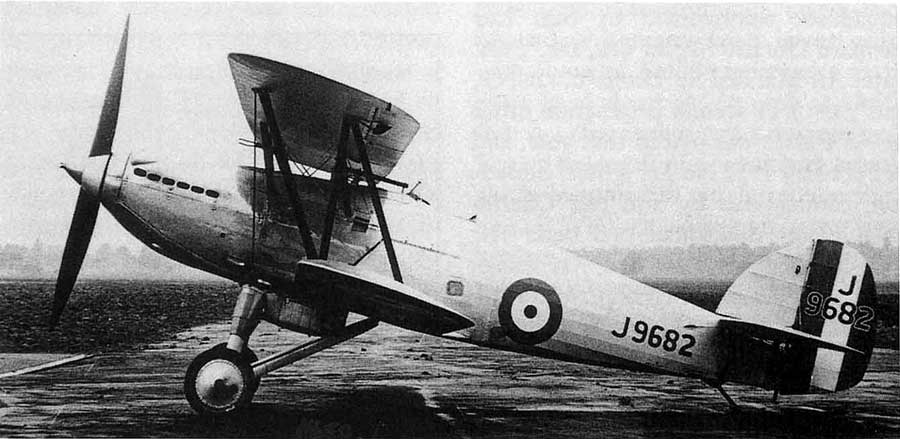
If you were to search for images of both the Hawker Hornet (Fury prototype) and its competition, the Fairey Firefly II, you will be surprised at just how similar the two aircraft actually were. In profile, they were almost identical, but from a construction perspective, there were some distinct differences. Whilst the Firefly adopted traditional wooden construction methods, the Hawker aircraft utilised the company’s highly successful tubular steel construction method, which produced a very strong, but relatively light aircraft, which are two absolutely critical attributes for a successful fighter design. The flight controls of the Hawker fighter were also found to be much lighter and more responsive than the Firefly, which made the aircraft a much better handling aeroplane, in its intended fighter role. Importantly, it was during the flight trials at Martlesham Heath that the Hawker Hornet achieved a level flight speed of 207 mph – all these factors were significant in leading the Air Ministry to select the Hawker Hornet for their new fighter design. At this time, the Air Ministry wanted their fighter aircraft to have names which reflected the ferocious nature of their intended use, so the Hornet was to be christened the Hawker Fury – it was to become the first interceptor aircraft in service with the Royal Air Force capable of speeds in excess of 200 mph.
When the Hawker Fury entered RAF service as the fastest fighter in their history, you might think that the Air Force would want to take every opportunity to promote the attributes of their new aircraft. In actual fact, the Hawker Fury was something of an embarrassment to the Air Ministry, although most observers prefer to describe it as something of a face-saver. The recent squadron introduction of the Hawker Hart light bomber highlighted a major deficiency in home defence capability, as it was faster than the Bristol Bulldog fighter, which had only recently entered service in very large numbers. The Hart was capable of 184 mph in level flight, whilst the latest front line interceptor (the Bristol Bulldog) was actually 10 mph slower – to polarize this situation further, in a bombing exercise which featured the new Hawker Hart bomber, the attacking aircraft were able to complete their mission almost unopposed by fighter defences. This was a worrying scenario for the RAF and was certainly not one that they would like to make public.
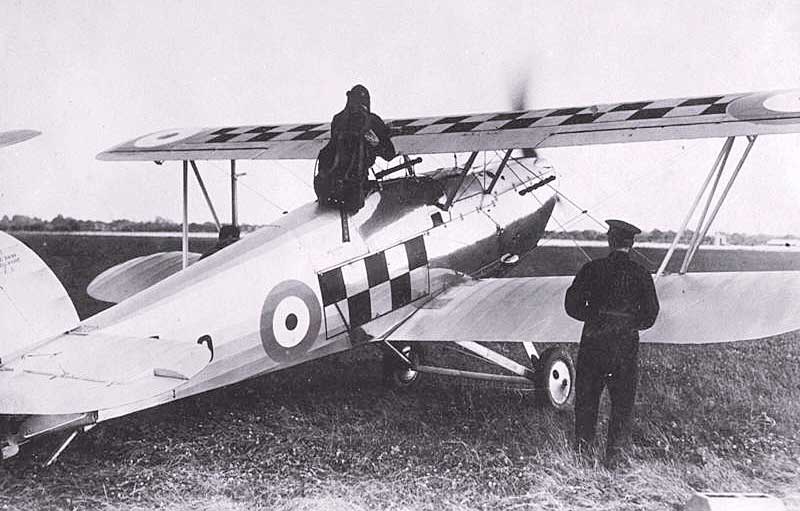
When the 200 mph Hawker Fury entered RAF service as one of the most capable fighter aircraft in the world at that time, you could be forgiven for thinking that the aircraft would become the standard fighter of this period. Unfortunately, this was not to be the case, as these were very strange times. I mentioned previously that this was a period of astonishing technological advances in the field of aviation, but it was also a time of severe economic austerity. Even though the Hawker Fury was a significant improvement on the Bristol Bulldog fighter, which was in widespread use by the RAF, the Hawker design was very much more expensive to manufacture and production orders placed were relatively modest. The Fury entered RAF service with No.43 squadron ‘The Fighting Cocks’, at Tangmere in 1931, where it was to serve until the squadron replaced them with the new Hawker Hurricane, in 1938. They were regarded as something of a hotrod fighter, requiring the very best pilots the RAF had available to handle this extremely capable aeroplane. As a consequence, some of the elite RAF fighter squadrons were to be linked with the Hawker Fury, as it also went on to serve with Nos.1 and 25 squadrons. Indeed, whilst serving with No.1 squadron, the unit was to gain a reputation for aerobatic prowess in their gleaming Hawker biplane fighters, giving displays at venues all over the world and promoting the skill and professionalism of the modern Royal Air Force.
As well as being a highly advanced, highly capable combat aircraft, the Hawker Fury was without doubt one of the most attractive aeroplanes ever produced. Everything about it was cultured – sleek, sophisticated and highly polished, the Hawker Fury was surely just too handsome to fight! You might even think that potential adversaries would hate to come up against the Fury in combat – they would either be shot down whilst spending too much time admiring this beautiful aircraft, or would simply find it too distressing to fire at something so attractive. In any case, the advancement in aviation design and the gathering clouds of war dictated that the Hawker Fury would not see combat with the RAF during WWII, having already been relegated to secondary roles – importantly, as it served during this very specific period in the history of the RAF, only 118 Fury’s were actually built for the Royal Air Force.
As we have already discussed, the Hawker Fury did not see service with the RAF during the Second World War, however it did serve with a number of foreign air forces and actually saw combat against Axis forces. Although it did have some limited combat successes, the Fury was obsolete by the time of WWII and the majority of these engagements were to end in a predictable way, with the gallant Fury pilots falling to the guns of a more advanced enemy aircraft. For this reason and the fact that the few aircraft that were still retained by the RAF were more or less surplus to requirements, almost all of the remaining aircraft were either destroyed, or scrapped – indeed, there is only one Hawker Fury remaining to this day, but astonishingly, it is in airworthy condition and has just returned to the UK Airshow circuit. Let us take a closer look at this unique and extremely historic aeroplane.

Anyone who has been lucky enough to see Hawker Fury Mk.I K5674 (G-CBZP) in person, cannot fail but to be impressed by this spectacularly attractive aeroplane. The only surviving aircraft of its type in the world, it has been restored to an extremely high standard and despite the undoubted value of this unique piece of history, it’s owners actually fly the aeroplane, allowing us all to experience something of this golden era in British aviation.
Historically, with no surviving examples of the Hawker Fury known to exist, this handsome aeroplane seemed lost to the world forever, until a chance discovery in South Africa. Following a tip off from RAF museum staff, a team from the Historic Aircraft Collection, based at Duxford airfield, headed for a farm in South Africa, where they discovered the extremely rare remains of a Hawker Fury fighter – these were quickly secured and plans were made to have them returned to the UK, where they would form the basis of an ambitious restoration project.
Hawker Fury Mk.I was taken on charge with the RAF in 1935 and given the serial number K5674. It was transferred to No.2 Aircraft Storage Unit, at Cardington, Bedfordshire, before moving on to its first operational squadron – No.43 ‘Fighting Cocks’ squadron, at Tangmere, Sussex. Whilst at Tangmere, the Fury was the personal aircraft of Flying Officer Frederick Rosier, who had it noted in his log book as being his aircraft, whilst he was Officer Commanding ‘B Flight’, between December 1936 and January 1939. It was also noted that the aircraft carried the name ‘Queen of the North and South’, although it is not sure if this was just a name that Rosier gave to his aircraft and it was not actually carried on the fuselage. There is currently no photographic evidence to prove that the aircraft carried the name, but if such evidence ever came to light, it would be of huge interest to the Historic Aircraft Collection.
The last time that Flying Officer Rosier flew Hawker Fury K5674 was on 22nd February, 1939 – his log book entry for this day read ‘Last fling in Queen of the North and South. Perfect!’ It is also thought that just before he ended his association with this particular aircraft, he had to endure the distressing sight of the beautifully flamboyant No.43 squadron ‘Fighting Cocks’ paint scheme, being replaced with the standard green and brown fighter camouflage of 1939 – this must have been a real sign of things to come! Following periods with RAF maintenance units at Kemble and Sealand, the Fury was eventually struck off charge in August 1940.
The future of the aircraft was now to be very much linked with a new career in South Africa. Transported on board the ship M.V. Clan Mathieso, the aircraft was unloaded at Durban in late 1940 and re-assembled for No.13 squadron, South African Air Force, based at Swartkop. Unfortunately, its South African career was to be a short one – we have already seen how the Fury was a bit of a handful to fly, with only the most capable pilots selected to fly it. On 31st March 1941, whilst being flown by pilot 2nd/Lt. Peter M Hedley, the aircraft ran out of fuel and made a forced landing at Pitsani, near Krugerdorp. Thankfully, the pilot was unhurt, but the aircraft suffered Cat 2 damage and was transported to No.2 Air Depot, Kimberley, where it was scrapped. From this date, little is know about the aircraft, until its remains were discovered on farmland and identified as a Hawker Fury in 1992 – it then became subject to one of the most ambitious restoration projects undertaken in recent years. Would this extremely rare aircraft ever make it back into the air again?
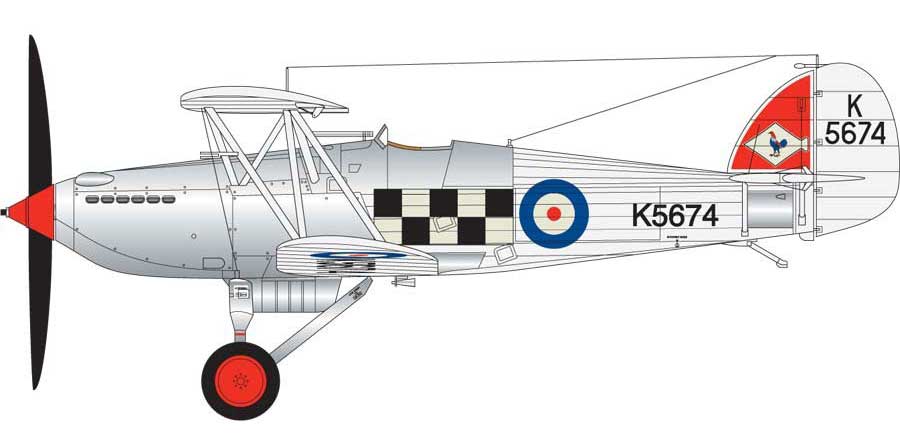
As soon as they had acquired the remains of Hawker Fury K5674, the incredibly challenging task of trying to restore one of the world’s rarest aircraft began in earnest. From the outset, the team were only interested in undertaking this project if they could restore the aircraft to its original, authentic condition and it cannot be stressed just how difficult a task this was actually going to be. With few original parts available to the restoration team and the complex manufacturing processes used in its construction long since disappearing, this was clearly going to be a very lengthy, costly and time consuming project indeed.
Retrotec Ltd are a specialist historic aviation restoration company, based in East Sussex, who have built a reputation of engineering excellence in the restoration of rare aircraft types. Already linked with a number of high profile aviation projects, the company is particularly proficient in working with classic Hawker biplane aircraft, but despite these unique credentials, the Fury was going to be by far and away the most challenging project they had attempted to date. Long forgotten manufacturing processes would have to be resurrected and parts for this highly complex aircraft would have to be completely re-manufactured if the Fury was to take to the skies once more, but despite these significant hurdles, the Retrotec engineers took to their task with relish – they were determined to achieve something very special in the world of historic aviation!
From the outset of this restoration, it was clear that the project was going to be a long term one and as enthusiasts became aware of this development, they were rightly excited, but also prepared for something of a long haul. Having accepted the complexities of bringing old aeroplanes back to life, it is understandable that much of the work undertaken by restoration companies like Retrotec should be kept out of the public domain and with the passage of time, projects such as this can fall off the radar somewhat. The Hawker Fury was to remain in the workshop for the next 18 years, but what Retrotec managed to achieve was nothing short of astonishing – every restoration project has its particular merits and there is no doubting that enthusiasts certainly have their own opinions on the types of aircraft that they are passionate about, but this project has to be regarded as one of the finest aviation restoration works ever produced. In many aviation circles, the Hawker Fury is regarded as something of a restoration masterpiece and the team at Retrotec must be so proud of this historic achievement.
In keeping with the authentic nature of the entire restoration, the aircraft has been finished in the colours it wore whilst it was the personal aircraft of Flying Officer Frederick Rosier, whilst with No.43 squadron at Tangmere, during the 1930’s. The restoration team were in contact with the son of F.O Frederick Rosier, who was able to provide them with a period photograph of the aircraft, which helped with the authenticity of the paint finish. In a word, this aircraft is magnificent and beautifully represents the classic era of British aviation, from between the wars.
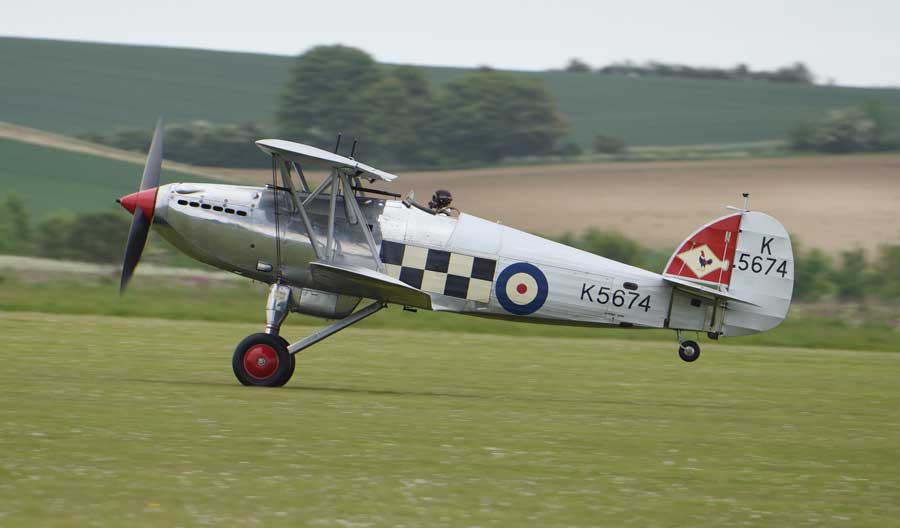
After the mammoth eighteen year restoration had been completed, K5674 was first unveiled on the historic aviation world at IWM Duxford, in June 2011. Later that same year, the aircraft was on display at the Goodwood Revival meeting, where she was awarded first place in the Spirit of Aviation section – a fitting tribute to the magnificent work completed by the Retrotec engineers. The aviation world was beginning to get excited now and surely the first post restoration test flight was only days away! Unfortunately, it proved to be almost a year before this momentous event could take place, as the CAA required detailed investigations to be carried out, which greatly delayed the planning of a first flight and incurred significant additional costs for the aircrafts owners. At the end of this frustrating delay, the Fury passed with flying colours and they were issued a permit to test – they were good to go!
On 30th July 2012, in the hands of experienced Warbird pilot Flt. Lt. Charlie Brown, Hawker Fury Mk.I K5674 took off from the grass runway at Goodwood, triumphantly completing this impressive and unique restoration project. The decision to fly from Goodwood was a significant one, as it was as close to the aircrafts original home base of Tangmere as possible, which was in keeping with the authentic nature of the entire project. This first flight was completed out of the gaze of spectators, in line with HAC policy – with an aircraft this rare, for which there is little flight guidance for the test pilot and even fewer surviving pilots to question, it would be down to the experience and professionalism of Charlie Brown to safely complete this first post restoration flight. In my book, this was more than enough pressure for the pilot to shoulder, without having the world’s media staring at you as well!
The flight went extremely well and other than the usual technical niggles associated with a first flight, it was to be considered a resounding success. A second flight took place on 6th August, but on this occasion, officials from HAC and Retrotec were present as was David Rosier, the son of Flying Officer Frederick Rosier, who saw his fathers aircraft take to the skies once more. He brought his fathers flight log-book with him, which he entrusted to pilot Charlie Brown for the duration of the flight, which took place in the same airspace around the old RAF Tangmere aerodrome (which is just a short distance from the airfield at Goodwood) – a fitting tribute to the history of this aircraft.
Following this high profile event, there was to be another frustrating period of hangar time for K5674, whilst all the information gathered from the two test flights was collated and any required remedial works carried out. The aircraft was not to fly again until 22nd April 2015, but this time, the team behind the Fury issued their intention for the aircraft to make its public display debut at the Duxford VE Day Anniversary Airshow the following month. For anyone with an interest in this period of British aviation, or who had been patiently watching progress of this unique project over the years, the Duxford show was now a ‘must attend’ event and we had our fingers crossed for decent weather.
I was lucky enough to attend the Saturday of the VE Day anniversary show and as usual, the British weather was less than ideal for this aerial spectacle. As the first major Airshow of the year, organisers were expecting large crowds over the weekend, particularly as there were advertised first public display flights for the Bristol Blenheim and the Historic Aircraft Collection Hawker Fury. Despite the best efforts of the weather, those who made the pilgrimage were to be rewarded with a feast of historic aviation and two extremely rare British aircraft would indeed take their place in the impressive display programme.
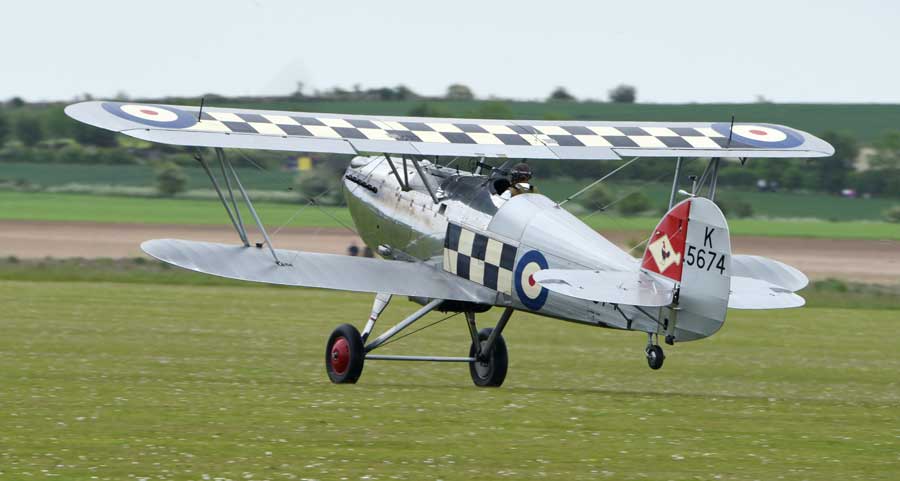
Under typically grey Duxford skies, the delightful HAC Hawker Fury taxied past an appreciative crowd, clearly flaunting its stunning good looks and instantly becoming a favourite of many an aviation enthusiast. In what must have been an extremely emotional occasion for the team behind the restoration, Charlie Brown expertly accelerated the Rolls Royce Kestrel engine of the Fury down the grass runway and caressed his unique and historic fighter into the air – a 23-year project had its triumphant reward! As if to celebrate this significant achievement, Charlie Brown proceeded to perform a flawless routine of low-level aerobatics, which perfectly illustrated the power and agility of the Hawker Fury and will have impressed a great many spectators. As we have already noted, the Fury is a really good-looking aeroplane and as a biplane, many would have expected it to give quite a docile display – nothing could be further from the truth! This aircraft is all about power and the noise generated from the Rolls Royce Kestrel engine is as unique as it is loud. It is clearly a very capable fighter aircraft – the fact that it is one of the best looking aeroplanes ever produced makes it doubly appealing. There is absolutely no doubt whatsoever that Hawker Fury K5674 is destined to become one of the best loved historic aircraft in the UK and I am already a fully besotted member of its appreciation society.
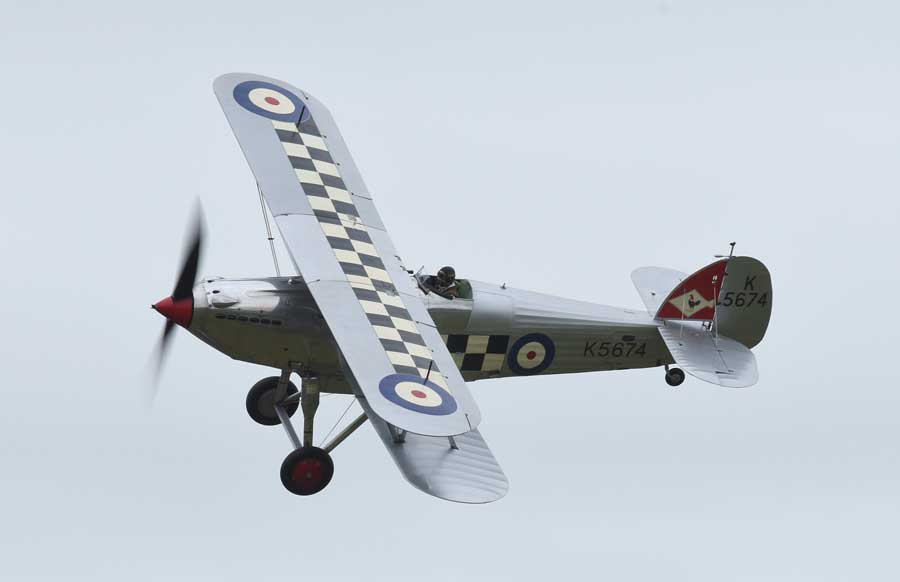
As a long standing Aviation Archive collector, I remember being extremely impressed when Corgi added the first fully rigged biplane aircraft models to their 1/72nd scale range. Like many of our readers, I cut my teeth by making Airfix models in my youth and had tried (and failed) many times to represent wire rigging on my inter-war biplane aircraft and had almost given up on the hope of mastering this difficult technique. Would I ever be able to have an accurate, biplane model in my collection? When I heard that Corgi had found a way of including rigging on their models, I have to admit that I was a little sceptical. I really could not see how this could be done, certainly not without the models being prohibitively expensive, but I placed my order in any case and waited in anticipation. What they managed to achieve was hugely impressive and it was done without a significant price increase – the Fairey Swordfish and Gloster Gladiator were duly added to my collection.
Corgi’s biplane models are without doubt, some of the most impressive models in the die-cast collecting hobby and the range continues to grow in both popularity and aircraft subjects covered. The latest model to be introduced to the range is the handsome Hawker Fury Mk.I and the first release from this tooling is the subject of this week’s Aerodrome – Hawker Fury Mk.I K5674. The Fury occupies an important position in the history of the RAF, as the first fighter to exceed 200 mph in level flight and possibly the absolute pinnacle of biplane fighter technology. Corgi have managed to capture the handsome good looks of the Fury and have incorporated the wire rigging featured on the real aircraft. As the Hawker Fury also represents the transition from biplane fighter technology to the more recognisable monoplane fighters of the Battle of Britain, this model really does need to be displayed next to the Hawker Hurricane that replaced it, in order to demonstrate the development of the fighter aircraft in the UK and indeed the development of Sidney Camm designed aircraft.
AA27301 - HAC Hawker Fury K5674 is available from your usual supplier now, or by clicking on this link and heading for the Corgi website. Once there, you will also see the second release in the series, which features an unusual camouflaged finish for the Hawker Fury, which was applied to the aircraft just before it was withdrawn from front line service, in the late 1930s.
I hope that you have enjoyed this little trip back into British aviation nostalgia and that you will join us again, for the next edition of Aerodrome. You can discuss this week's blog on the Aerodrome Forum, and if you have any comments, questions or suggestions for future editions, please feel free to let us know on. In addition, you can contact me on Corgi Twitter feed using #corgiaerodrome.
Thank you very much for reading.
Michael
© Hornby Hobbies Ltd. All rights reserved. Images © Hornby Hobbies and Michael Clegg unless otherwise credited.